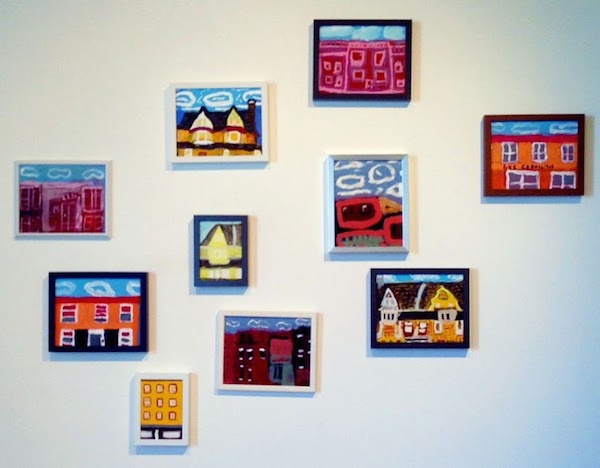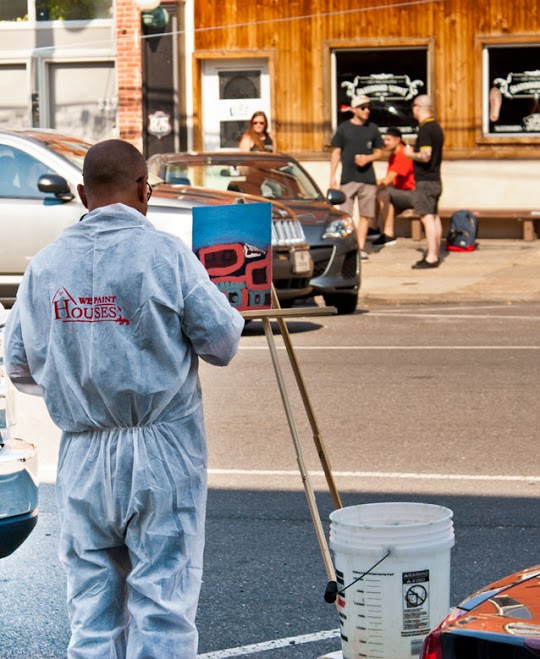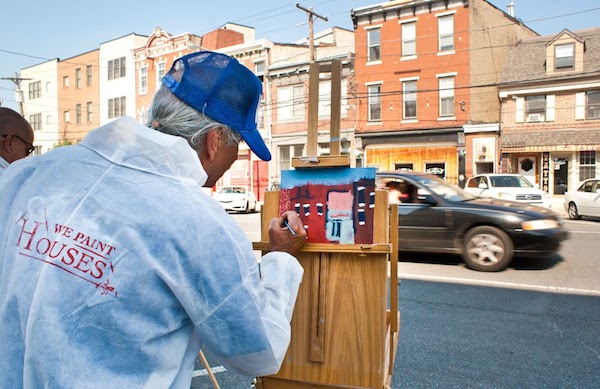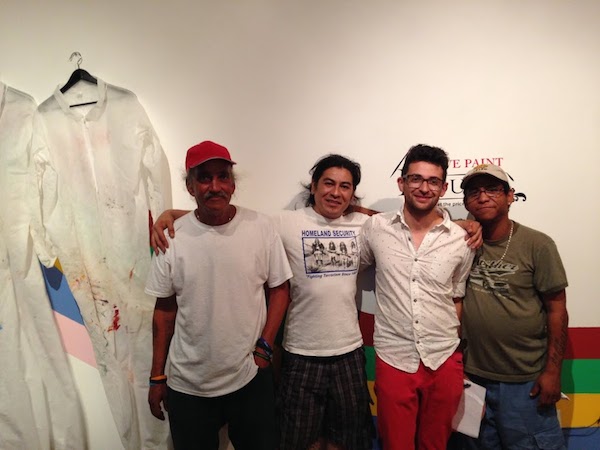[Noreen explains how a new public art project creates a lasting impact for participants and viewers. — the Artblog editors]
The city of Philadelphia is known far and wide for its public art–boasting a collection of 3,000 murals and growing. However, recent public art initiatives in the city have come under scathing criticism, with some even being decried as the product of gentrification. These projects focus on the aesthetic of a neighborhood and ignore its people. We Paint Houses, a two-month project organized by artist Felipe Castelblanco, does just the opposite.
Stage 1: Commenting on commercialization

The first part of the project opened on June 6, with an unusual installation that took me by surprise. My first impression was that the space was no longer a gallery, and that it had become an office for a small business. The walls lacked any works of art or adornment, except for mural-like stripes of paint; the title of the business; a map of the city; and a framed image of Christ.
Painter’s buckets and a handcart full of painting equipment sat in the corner, while a group of folding chairs and a handful of magazines announced a waiting area for clientele, boasting the gallery’s newfound utility rather than aesthetic focus. At the opening, a secretary waited behind a desk stocked with business cards, order forms, and paint swatches. During the hustle and bustle of First Friday, the project invited the viewer to become a customer.
Stage 2: Commissions

The second part of the installation, open from July 11-26, displays the transformation of commissions into works of art, and all the moments in between. During the first part of the installation, orders were taken for houses to be painted. Castelblanco then employed Latino day laborers to complete the works. The product–six original paintings, available for auction–hung next to a video projection of the painters at work.

There is a stronger emphasis on process and performance than the tangible outcome–a goal that Castelblanco clearly achieved. The project does not center on what hangs in the gallery, but rather directly engages the public across language barriers and socioeconomic constrictions.
Combating invisibility through immersion

For Castelblanco, a Spanish speaker, the language was no problem. Working with Mexican artist Brujo de la Mancha, the artist met his painting crew by approaching them on the street, near 10th and Vine streets. “When I came and visited the gallery in March, I noticed the activity in the area,” Castelblanco said. Here, many day laborers gather and wait for job offers. “This time, I walked by a couple of times, paying attention to the people I would see there […] and eventually I just went and approached them.”
After opening an initial conversation with two Cuban workers, Castelblanco learned about the daily conditions most laborers face. “They told me they could work for a day–12 hours–for like, 60 bucks, which is way under minimum wage. […] Some employers may pick them up and take them pretty far away, an hour outside of the city, and then they don’t return them. So they have to pay for transportation out of the money they made that day.”

Castelblanco proceeded to negotiate the conditions of the job with the workers: a luxury that most laborers do not often encounter. They described their ideal conditions as a job that offered them breaks, lunch, and water. Each painting session, Castelblanco and his crew arrived at the site, set up their easels in the shade, and began to paint, averaging three-and-a-half hours per session. The painters were paid $12 per hour, and received on-site painting instruction from the artist.
The performances created an environment in which this group of blue-collar Latino workers, normally marginalized and unseen, became a highly visible presence, inviting the pedestrian audience to engage. On one occasion, the group was visited by a school bus full of teenagers. Castelblanco explains: “They started asking all these questions, and looking at the laborers face-to-face and and trying to communicate with them–despite their lack of language skills.”

We Paint Houses brought this collaboration of day laborers into the public eye. The sidewalk studio–an intentional spectacle–opened a public dialogue between inhabitants of Philadelphia whose paths might never otherwise have crossed. It accomplished what many critics see as a failure of public art: to divert the focus of art from the aesthetic of a community to the people that live there.
We Paint Houses is on view now until July 26, 2014 at PRACTICE Gallery, 319 N 11th Street, Suite 2G, Philadelphia, PA 19107. Gallery visits are available on Saturdays from 2 – 6 pm or by appointment.









